Processing Polymer Blends of Mater-Bi® and Poly-L-(Lactic Acid) for Blown Film Application with Enhanced Mechanical Strength
Abstract
1. Introduction
2. Materials and Methods
2.1. Materials
2.2. Blend Preparation
2.3. Films Blowing
2.4. Differential Scanning Calorimetry (DSC)
2.5. Morphological Characterization
2.6. Rheological Properties in a Molten State
2.7. Dynamic Mechanical Analysis (DMA)
2.8. Tensile Tests
3. Results and Discussion
3.1. Tensile Tests
3.2. SEM Analysis
3.3. Dynamic Mechanical Analysis (DMA)
3.4. Thermal Properties
3.5. Rheological Properties
3.6. Disintegration Test
3.7. Film Blowing
4. Conclusions
Supplementary Materials
Author Contributions
Funding
Institutional Review Board Statement
Data Availability Statement
Acknowledgments
Conflicts of Interest
References
- Hahladakis, J.N.; Iacovidou, E.; Gerassimidou, S. Plastic Waste in a Circular Economy. In Plastic Waste and Recycling; Elsevier: Amsterdam, The Netherlands, 2020; pp. 385–399. [Google Scholar]
- Samantaray, P.K.; Little, A.; Wemyss, A.M.; Iacovidou, E.; Wan, C. Design and Control of Compostability in Synthetic Biopolyesters. ACS Sustain. Chem. Eng. 2021, 9, 9151–9164. [Google Scholar] [CrossRef]
- Pan, H.; Li, Z.; Yang, J.; Li, X.; Ai, X.; Hao, Y.; Zhang, H.; Dong, L. The Effect of MDI on the Structure and Mechanical Properties of Poly(Lactic Acid) and Poly(Butylene Adipate-Co-Butylene Terephthalate) Blends. RSC Adv. 2018, 8, 4610–4623. [Google Scholar] [CrossRef] [PubMed]
- Nagarajan, V.; Zhang, K.; Misra, M.; Mohanty, A.K. Overcoming the Fundamental Challenges in Improving the Impact Strength and Crystallinity of PLA Biocomposites: Influence of Nucleating Agent and Mold Temperature. ACS Appl. Mater. Interfaces 2015, 7, 11203–11214. [Google Scholar] [CrossRef] [PubMed]
- Nakayama, D.; Wu, F.; Mohanty, A.K.; Hirai, S.; Misra, M. Biodegradable Composites Developed from PBAT/PLA Binary Blends and Silk Powder: Compatibilization and Performance Evaluation. ACS Omega 2018, 3, 12412–12421. [Google Scholar] [CrossRef] [PubMed]
- Lim, L.T.; Auras, R.; Rubino, M. Processing Technologies for Poly(Lactic Acid). Prog. Polym. Sci. 2008, 33, 820–852. [Google Scholar] [CrossRef]
- Kolstad, J.J.; Vink, E.T.H.; de Wilde, B.; Debeer, L. Assessment of Anaerobic Degradation of IngeoTM Polylactides under Accelerated Landfill Conditions. Polym. Degrad. Stab. 2012, 97, 1131–1141. [Google Scholar] [CrossRef]
- Karamanlioglu, M.; Robson, G.D. The Influence of Biotic and Abiotic Factors on the Rate of Degradation of Poly(Lactic) Acid (PLA) Coupons Buried in Compost and Soil. Polym. Degrad. Stab. 2013, 98, 2063–2071. [Google Scholar] [CrossRef]
- Aversa, C.; Barletta, M. Addition of Thermoplastic Starch (TPS) to Binary Blends of Poly(Lactic Acid) (PLA) with Poly(Butylene Adipate-Co-Terephthalate) (PBAT): Extrusion Compounding, Cast Extrusion and Thermoforming of Home Compostable Materials. Chin. J. Polym. Sci. 2022, 40, 1269–1286. [Google Scholar] [CrossRef]
- Yokohara, T.; Yamaguchi, M. Structure and Properties for Biomass-Based Polyester Blends of PLA and PBS. Eur. Polym. J. 2008, 44, 677–685. [Google Scholar] [CrossRef]
- Tabasi, R.Y.; Ajji, A. Selective Degradation of Biodegradable Blends in Simulated Laboratory Composting. Polym. Degrad. Stab. 2015, 120, 435–442. [Google Scholar] [CrossRef]
- Serra-Parareda, F.; Delgado-Aguilar, M.; Espinach, F.X.; Mutjé, P.; Boufi, S.; Tarrés, Q. Sustainable Plastic Composites by Polylactic Acid-Starch Blends and Bleached Kraft Hardwood Fibers. Compos. B Eng. 2022, 238, 109901. [Google Scholar] [CrossRef]
- Syafiq, R.; Sapuan, S.M.; Zuhri, M.Y.M.; Ilyas, R.A.; Nazrin, A.; Sherwani, S.F.K.; Khalina, A. Antimicrobial Activities of Starch-Based Biopolymers and Biocomposites Incorporated with Plant Essential Oils: A Review. Polymers 2020, 12, 2403. [Google Scholar] [CrossRef] [PubMed]
- Mistretta, M.C.; Botta, L.; Arrigo, R.; Leto, F.; Malucelli, G.; la Mantia, F.P. Bionanocomposite Blown Films: Insights on the Rheological and Mechanical Behavior. Polymers 2021, 13, 1167. [Google Scholar] [CrossRef] [PubMed]
- Scaffaro, R.; Maio, A.; Lopresti, F. Physical Properties of Green Composites Based on Poly-Lactic Acid or Mater-Bi® Filled with Posidonia Oceanica Leaves. Compos. Part A Appl. Sci. Manuf. 2018, 112, 315–327. [Google Scholar] [CrossRef]
- de Cássia Dutra , E.; de Souza , A.G.; dos S. Rosa , D. Effect of the Joncryl® ADR Compatibilizing Agent in Blends of Poly(Butylene Adipate-Co-Terephthalate)/Poly(Lactic Acid). Macromol. Symp. 2019, 383, 1800035. [Google Scholar] [CrossRef]
- Lorenzo, A.T.; Arnal, M.L.; Albuerne, J.; Müller, A.J. DSC Isothermal Polymer Crystallization Kinetics Measurements and the Use of the Avrami Equation to Fit the Data: Guidelines to Avoid Common Problems. Polym. Test. 2007, 26, 222–231. [Google Scholar] [CrossRef]
- Deng, Y.; Yu, C.; Wongwiwattana, P.; Thomas, N.L. Optimising Ductility of Poly(Lactic Acid)/Poly(Butylene Adipate-Co-Terephthalate) Blends Through Co-Continuous Phase Morphology. J. Polym. Environ. 2018, 26, 3802–3816. [Google Scholar] [CrossRef]
- Wang, B.; Jin, Y.; Kang, K.; Yang, N.; Weng, Y.; Huang, Z.; Men, S. Investigation on Compatibility of PLA/PBAT Blends Modified by Epoxy-Terminated Branched Polymers through Chemical Micro-Crosslinking. E-Polymers 2020, 20, 39–54. [Google Scholar] [CrossRef]
- Arruda, L.C.; Magaton, M.; Bretas, R.E.S.; Ueki, M.M. Influence of Chain Extender on Mechanical, Thermal and Morphological Properties of Blown Films of PLA/PBAT Blends. Polym. Test. 2015, 43, 27–37. [Google Scholar] [CrossRef]
- Miles, I.S.; Zurek, A. Preparation, Structure, and Properties of Two-Phase Co-Continuous Polymer Blends. Polym. Enginering Sci. 1988, 28, 796–805. [Google Scholar] [CrossRef]
- Al-Itry, R.; Lamnawar, K.; Maazouz, A. Improvement of Thermal Stability, Rheological and Mechanical Properties of PLA, PBAT and Their Blends by Reactive Extrusion with Functionalized Epoxy. Polym. Degrad. Stab. 2012, 97, 1898–1914. [Google Scholar] [CrossRef]
- Ma, P.; Cai, X.; Zhang, Y.; Wang, S.; Dong, W.; Chen, M.; Lemstra, P.J. In-Situ Compatibilization of Poly(Lactic Acid) and Poly(Butylene Adipate-Co-Terephthalate) Blends by Using Dicumyl Peroxide as a Free-Radical Initiator. Polym. Degrad. Stab. 2014, 102, 145–151. [Google Scholar] [CrossRef]
- Abdelwahab, M.A.; Taylor, S.; Misra, M.; Mohanty, A.K. Thermo-Mechanical Characterization of Bioblends from Polylactide and Poly(Butylene Adipate-Co-Terephthalate) and Lignin. Macromol. Mater. Eng. 2015, 300, 299–311. [Google Scholar] [CrossRef]
- Wu, D.; Huang, A.; Fan, J.; Xu, R.; Liu, P.; Li, G.; Yang, S. Effect of Blending Procedures and Reactive Compatibilizers on the Properties of Biodegradable Poly(Butylene Adipate-Co-Terephthalate)/Poly(Lactic Acid) Blends. J. Polym. Eng. 2021, 41, 95–108. [Google Scholar] [CrossRef]
- Zhang, Z.C.; Gao, X.R.; Hu, Z.J.; Yan, Z.; Xu, J.Z.; Xu, L.; Zhong, G.J.; Li, Z.M. Inducing Stereocomplex Crystals by Template Effect of Residual Stereocomplex Crystals during Thermal Annealing of Injection-Molded Polylactide. Ind. Eng. Chem. Res. 2016, 55, 10896–10905. [Google Scholar] [CrossRef]
- Li, H.; Huneault, M.A. Effect of Nucleation and Plasticization on the Crystallization of Poly(Lactic Acid). Polymer 2007, 48, 6855–6866. [Google Scholar] [CrossRef]
- Kim, S.K. Collective Viscosity Model for Shear Thinning Polymeric Materials. Rheol. Acta 2020, 59, 63–72. [Google Scholar] [CrossRef]
- Corre, Y.M.; Duchet, J.; Reignier, J.; Maazouz, A. Melt Strengthening of Poly (Lactic Acid) through Reactive Extrusion with Epoxy-Functionalized Chains. Rheol Acta 2011, 50, 613–629. [Google Scholar] [CrossRef]
- Mallet, B.; Lamnawar, K.; Maazouz, A. Improvement of Blown Film Extrusion of Poly(Lactic Acid): Structure-Processing-Properties Relationships. Polym. Eng. Sci. 2014, 54, 840–857. [Google Scholar] [CrossRef]
- Herrera, N.; Roch, H.; Salaberria, A.M.; Pino-Orellana, M.A.; Labidi, J.; Fernandes, S.C.M.; Radic, D.; Leiva, A.; Oksman, K. Functionalized Blown Films of Plasticized Polylactic Acid/Chitin Nanocomposite: Preparation and Characterization. Mater. Des. 2016, 92, 846–852. [Google Scholar] [CrossRef]
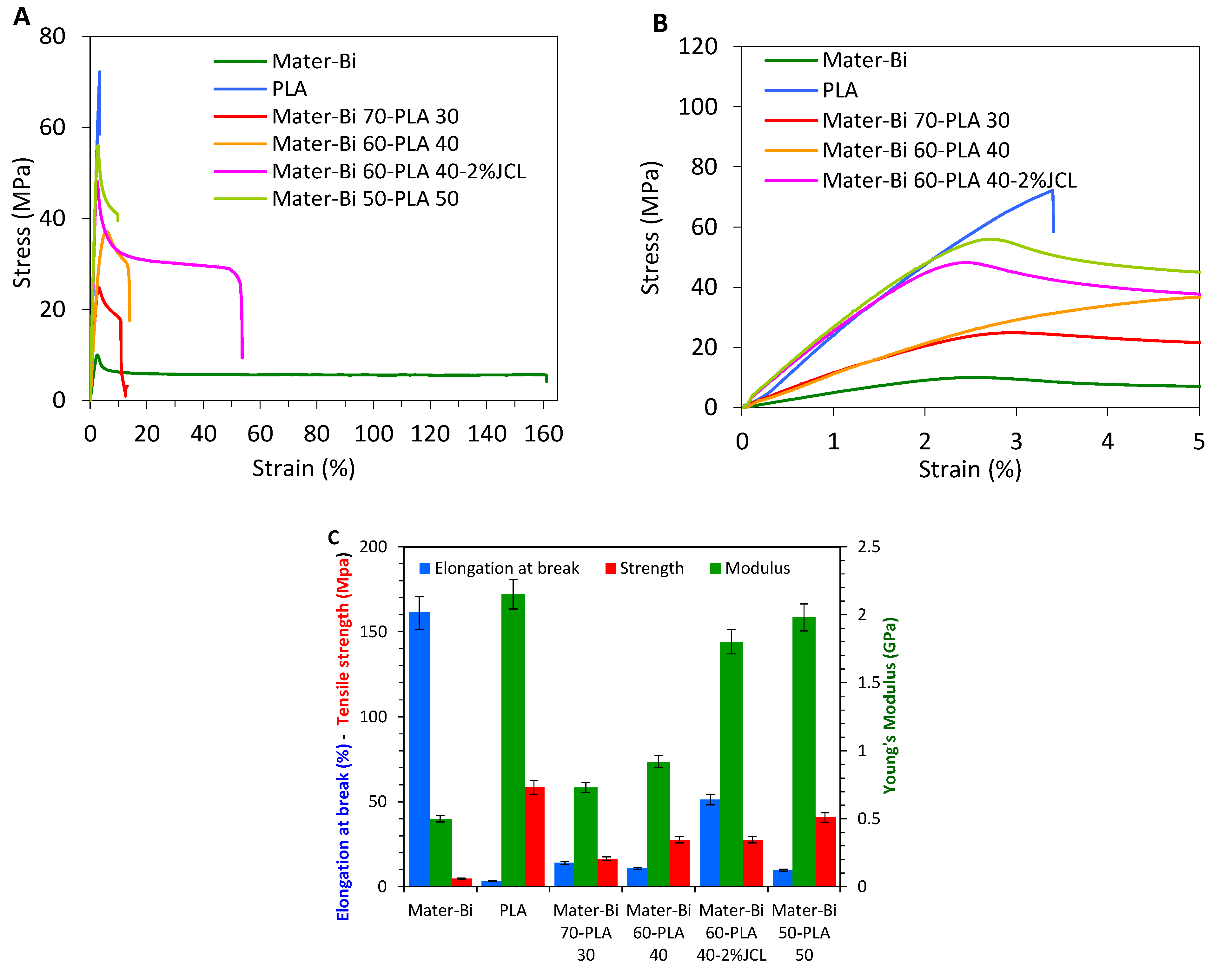
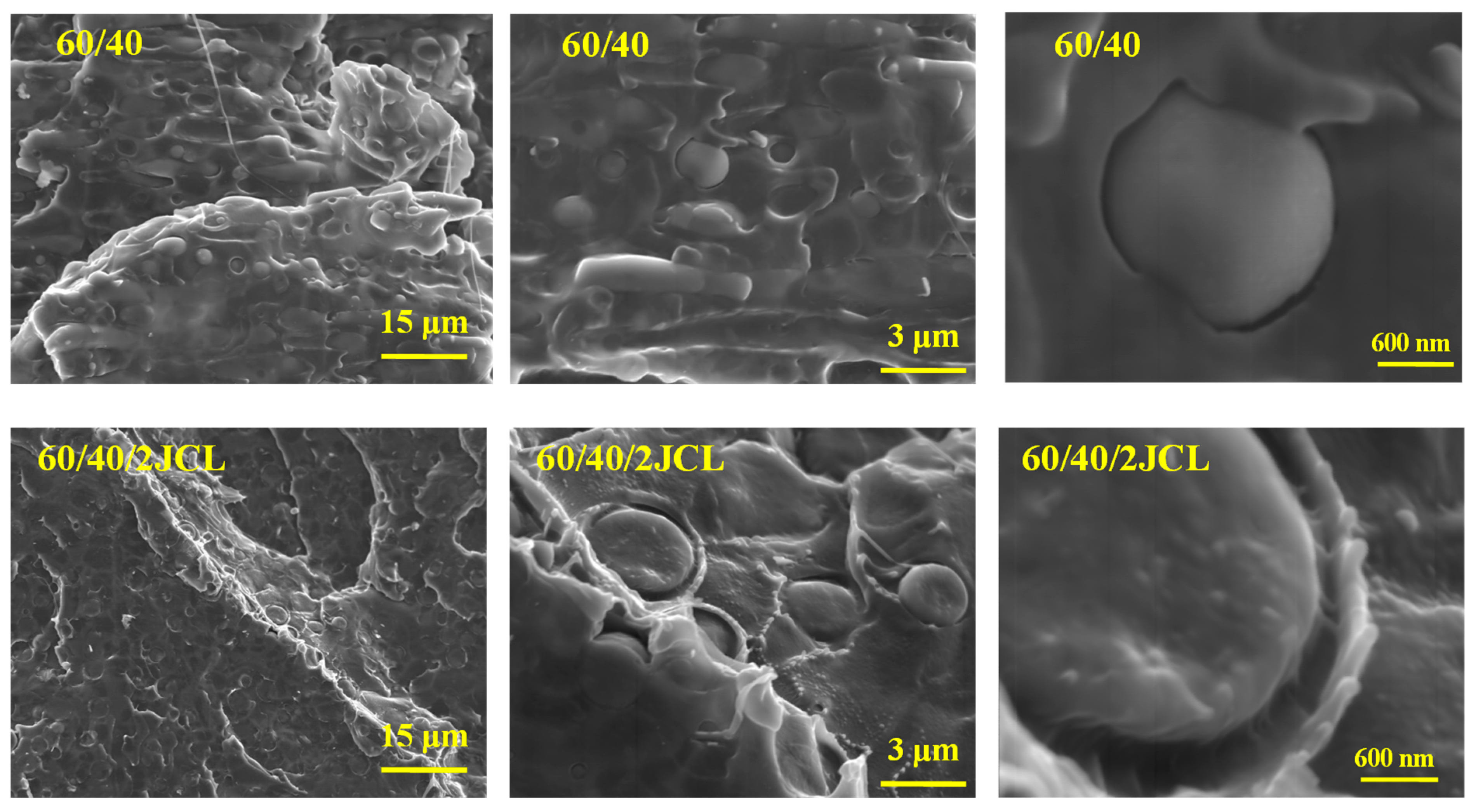
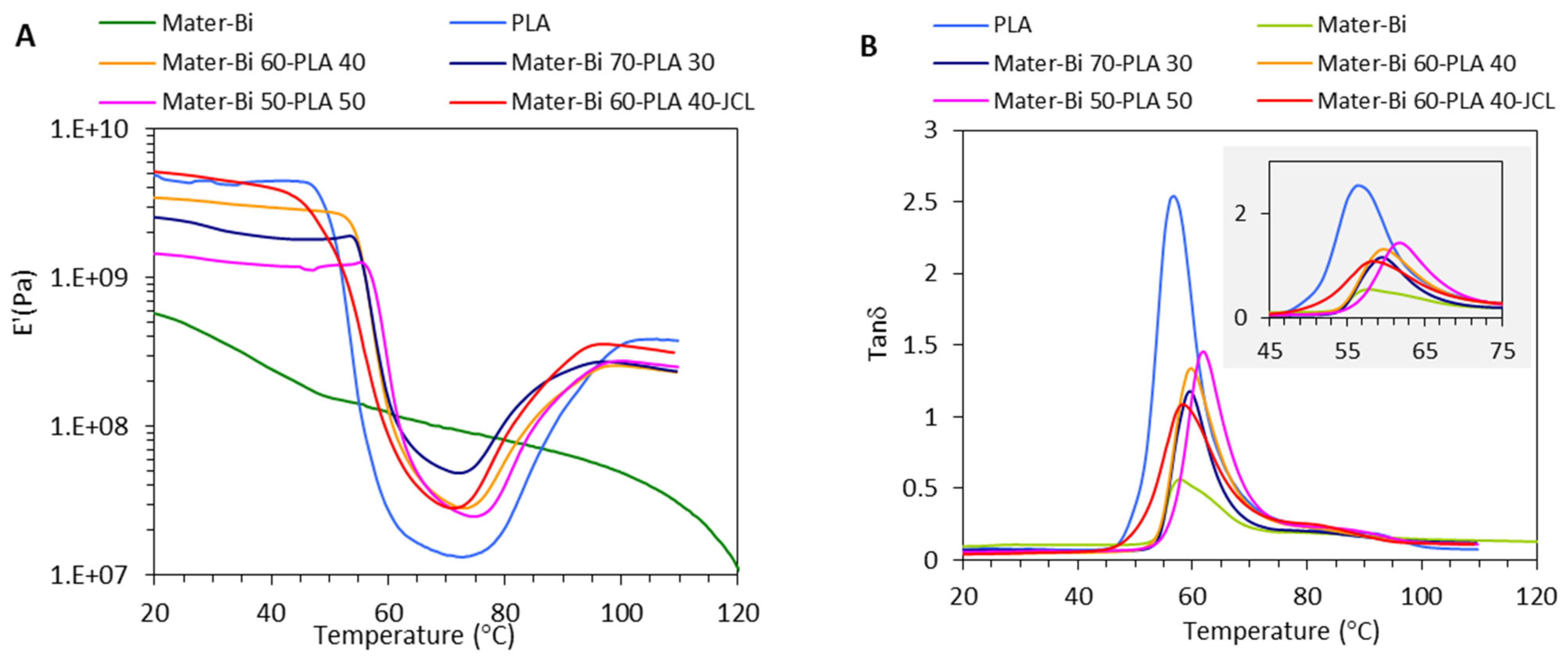
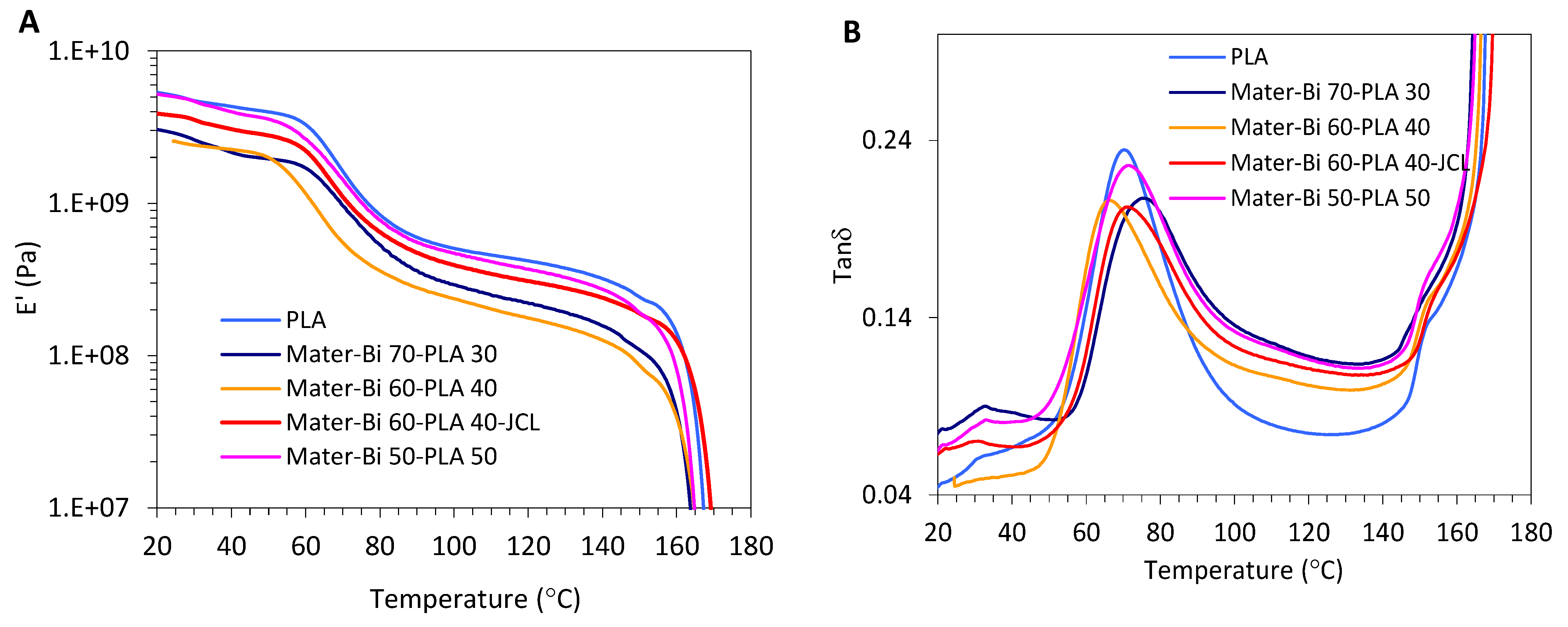
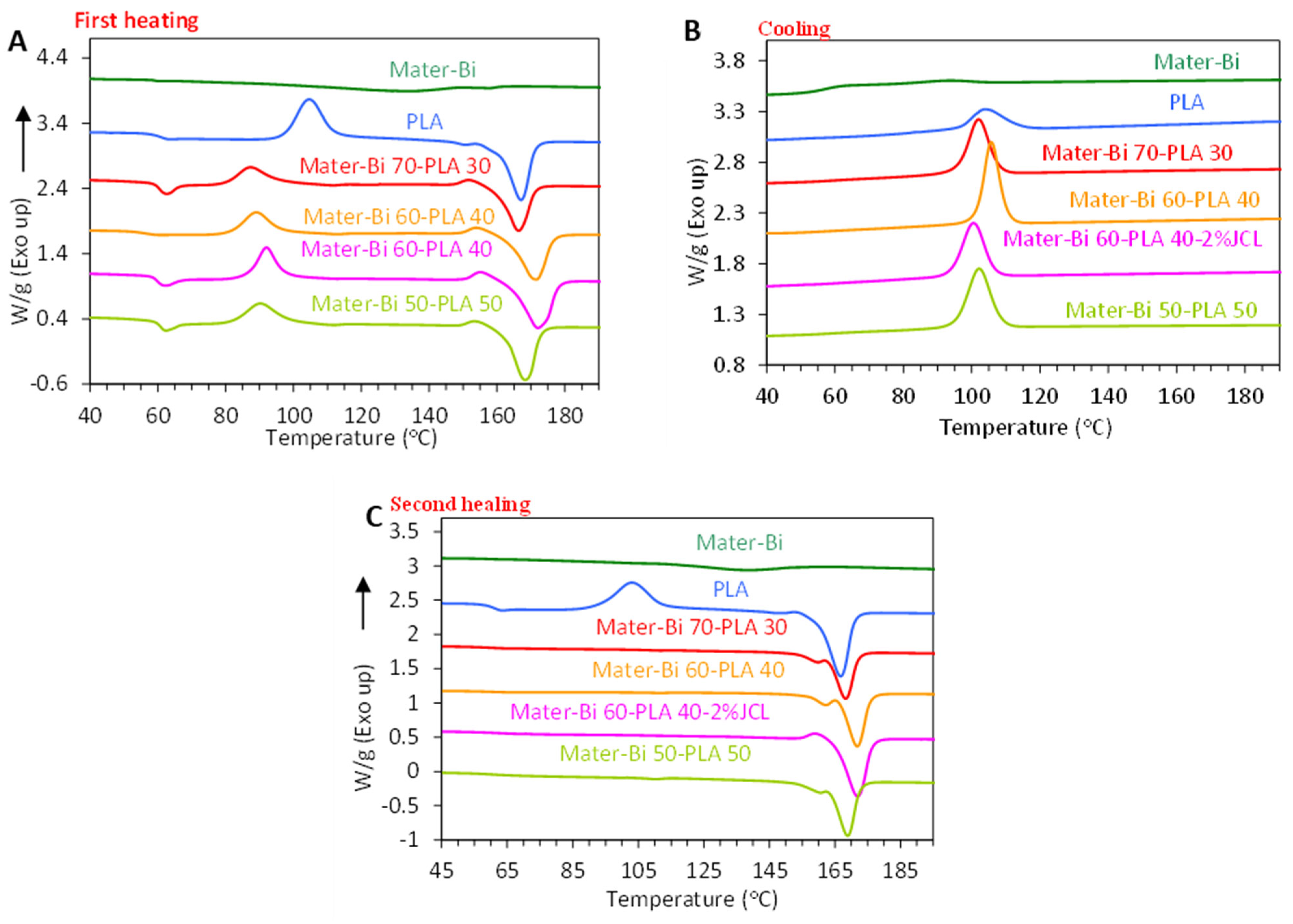

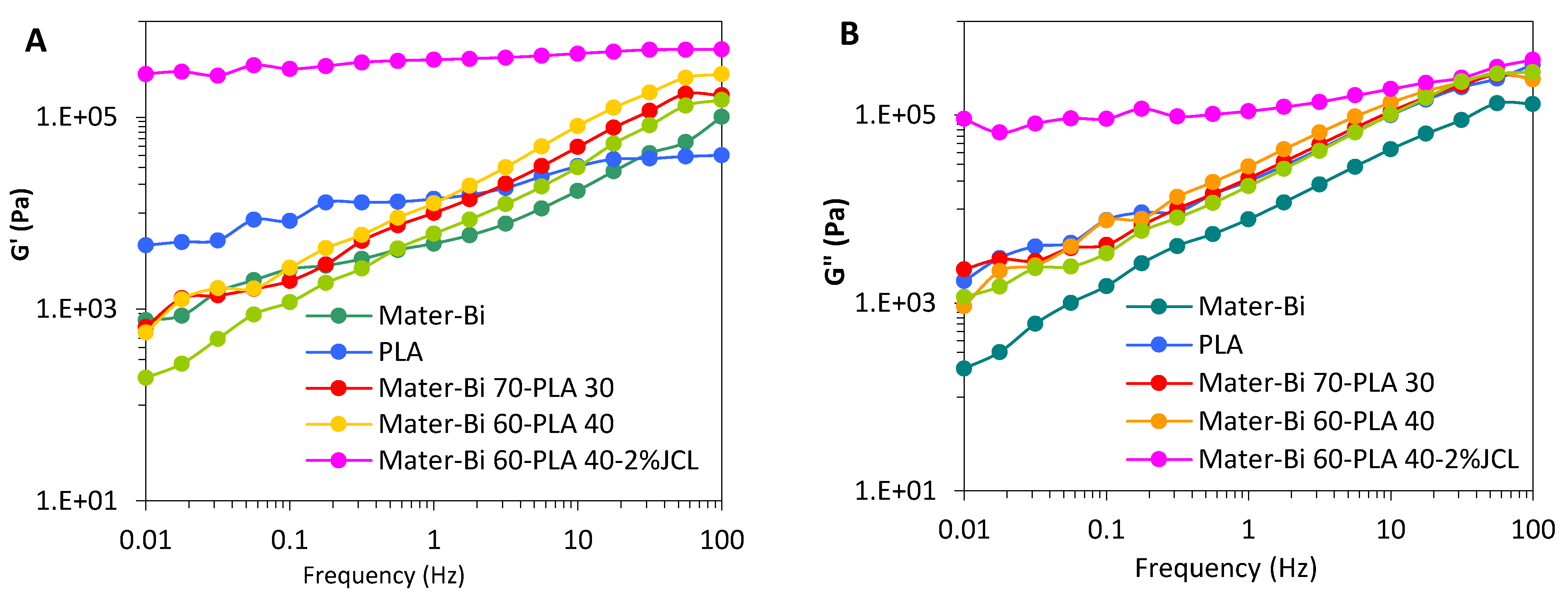
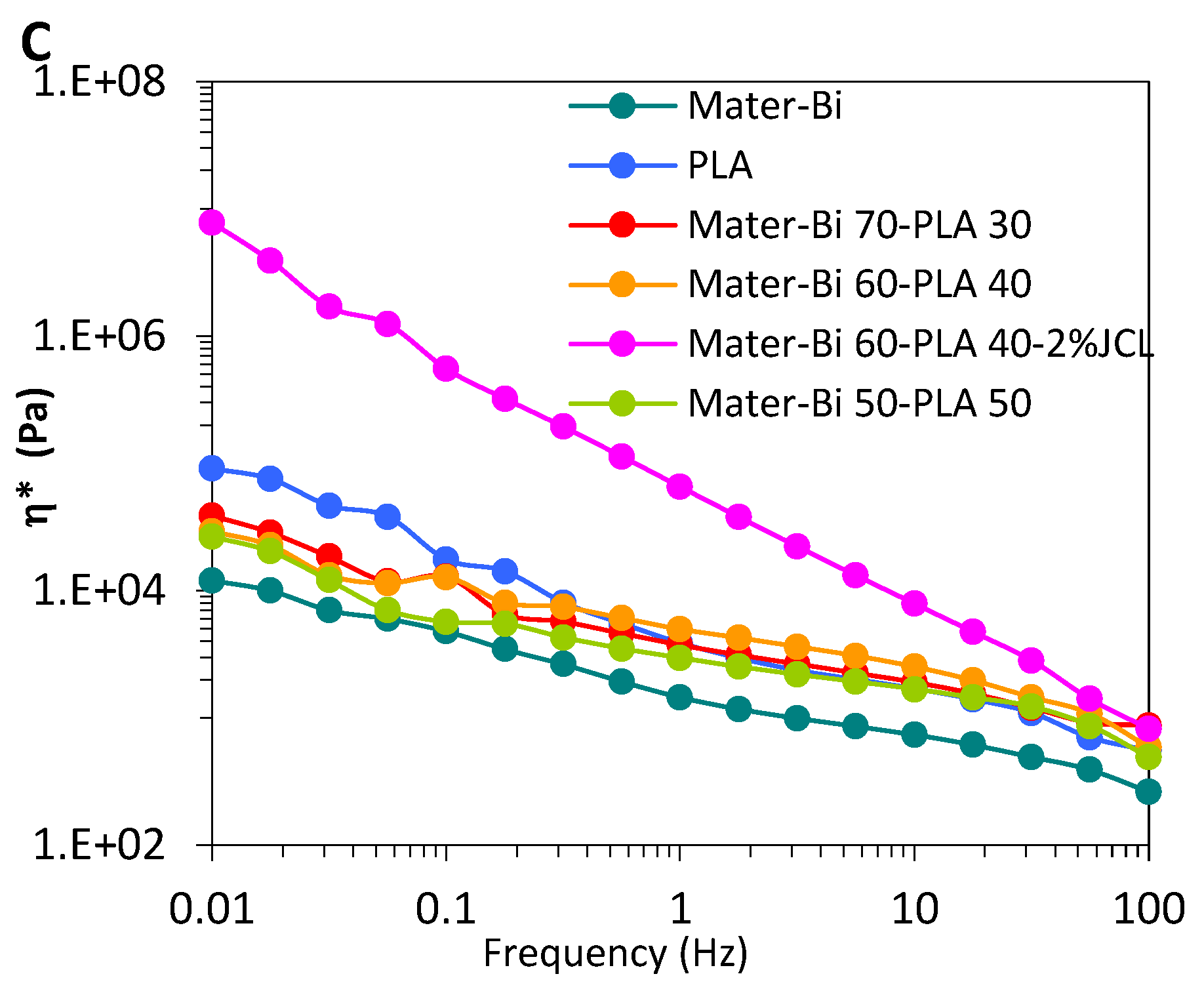
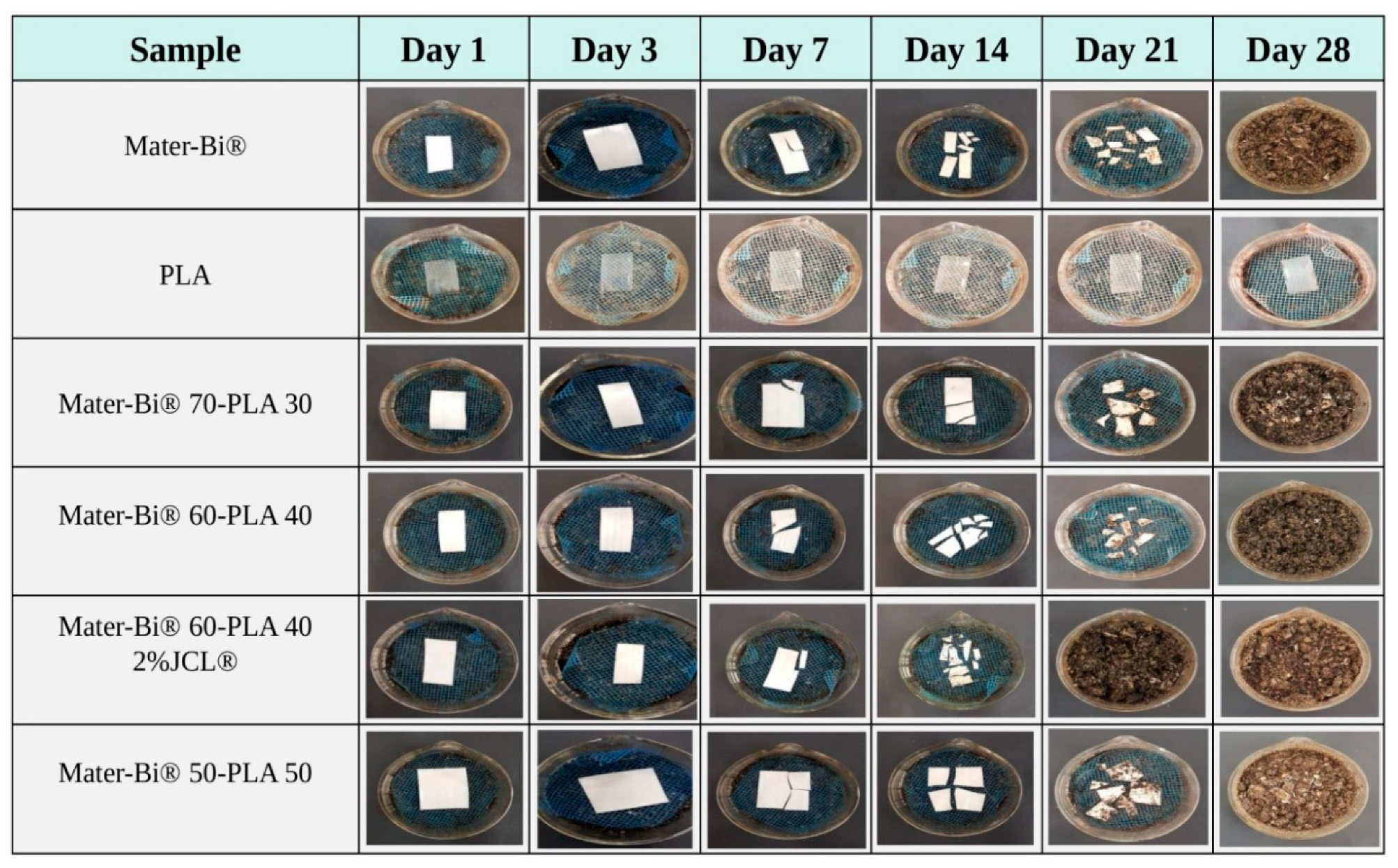

| Material | Information |
|---|---|
| Mater-Bi® Grade: Mater-Bi® YI0140/C | Supplier: Novamont MFI *: 33.36 g/10 min Density: 1.24 g/cc Melting point: 190 °C |
| PLLA Grade: Ingeo® biopolymer 3D870 | Supplier: Natureworks MFI *: 9 g/10 min Density: 1.24 g/cc Melting point: 130 °C |
| Joncryl-ADR® | Supplier: BASF Epoxy equivalent weight (g/mol) 310 Glass transition temperature:59 °C |
| Composition. | Mater-Bi® (wt%) | PLLA (wt%) | Joncryl-ADR® (wt%) |
|---|---|---|---|
| Mater-Bi® | 100 | - | - |
| PLLA | - | 100 | - |
| MB/PLLA-70/30 | 70 | 30 | - |
| MB/PLLA-60/40 | 60 | 40 | - |
| MB/PLLA/JCL-60/40/2 | 60 | 40 | 2 |
| MB/PLLA-50/50 | 50 | 50 | - |
| Blown Extrusion Parameters | Values |
|---|---|
| Lay-flat width | 118 mm |
| Bubble diameter | 75 mm |
| Die diameter | 45 mm |
| Die gap | 0.8 mm |
| Film thickness | 0.04 mm |
| Blow-up ratio (BUR) | 1.6 |
| Draw blow-up ratio (DDR) | 12.5 |
| Tg1 (°C) | Tg2 (°C) | Tcc (°C) | Tm (°C) | ΔHcc (J/g) | ΔHm (J/g) | χc (%) | |
|---|---|---|---|---|---|---|---|
| Mater-Bi | −33 | - | - | 133 | - | - | - |
| PLLA | 62 | 106.1 | 168 | 35.09 | −42.21 | 7.6 | |
| Mater-Bi 70-PLLA 30 | −38 | 63.8 | 88.6 | 167.3 | 19.56 | −32.95 | 47.5 |
| Mater-Bi 60-PLLA 40 | −37 | 62.1 | 90.5 | 172.6 | 19.15 | −38.8 | 52.8 |
| Mater-Bi 60-PLLA 40-2%JCL | −40 | 62.8 | 93.1 | 173 | 21.59 | −41.11 | 52.4 |
| Mater-Bi 50-PLLA 50 | 63.8 | 91.6 | 169.5 | 20.96 | 1.66 | 41.5 |
| Blend | Avrami Index (n) | t1/2 Theo (min) | t1/2 Exp (min) | K (min-n) | R2 |
|---|---|---|---|---|---|
| Neat PLLA | 2.36 | 6.613 | 6.217 | 0.01512 | 0.9998 |
| Mater-Bi 60-PLLA 40 | 3.47 | 2.185 | 2.167 | 0.0457 | 0.9998 |
| Mater-Bi 60-PLLA 40–2%JCL | 3.35 | 1.231 | 1.33 | 0.0812 | 1 |
| Elongation at Break (%) | Young Modulus (MPa) | Ultimate Tensile Strength (MPa) | ||||
|---|---|---|---|---|---|---|
| Mater-Bi® | 570 | 510.2 | 24 | |||
| HD-PE | 420 | 600 | 26 | |||
| Mater-Bi®/60%-PLLA 40 –2%JCL | MD | TS | MD | TS | MD | TS |
| 113 | 107 | 2321 | 1971.5 | 49.9 | 42.9 | |
Disclaimer/Publisher’s Note: The statements, opinions and data contained in all publications are solely those of the individual author(s) and contributor(s) and not of MDPI and/or the editor(s). MDPI and/or the editor(s) disclaim responsibility for any injury to people or property resulting from any ideas, methods, instructions or products referred to in the content. |
© 2022 by the authors. Licensee MDPI, Basel, Switzerland. This article is an open access article distributed under the terms and conditions of the Creative Commons Attribution (CC BY) license (https://creativecommons.org/licenses/by/4.0/).
Share and Cite
Bouzidi, S.; Ben ayed, E.; Tarrés, Q.; Delgado-Aguilar, M.; Boufi, S. Processing Polymer Blends of Mater-Bi® and Poly-L-(Lactic Acid) for Blown Film Application with Enhanced Mechanical Strength. Polymers 2023, 15, 153. https://doi.org/10.3390/polym15010153
Bouzidi S, Ben ayed E, Tarrés Q, Delgado-Aguilar M, Boufi S. Processing Polymer Blends of Mater-Bi® and Poly-L-(Lactic Acid) for Blown Film Application with Enhanced Mechanical Strength. Polymers. 2023; 15(1):153. https://doi.org/10.3390/polym15010153
Chicago/Turabian StyleBouzidi, Samar, Emna Ben ayed, Quim Tarrés, Marc Delgado-Aguilar, and Sami Boufi. 2023. "Processing Polymer Blends of Mater-Bi® and Poly-L-(Lactic Acid) for Blown Film Application with Enhanced Mechanical Strength" Polymers 15, no. 1: 153. https://doi.org/10.3390/polym15010153
APA StyleBouzidi, S., Ben ayed, E., Tarrés, Q., Delgado-Aguilar, M., & Boufi, S. (2023). Processing Polymer Blends of Mater-Bi® and Poly-L-(Lactic Acid) for Blown Film Application with Enhanced Mechanical Strength. Polymers, 15(1), 153. https://doi.org/10.3390/polym15010153









